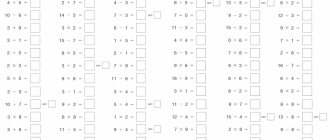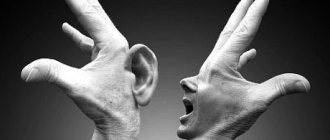Auditory memory in children
Auditory memory is a type of figurative memory, which consists of processes such as imprinting, storing and reproducing auditory images.
The ability to learn through oral explanations and instructions is considered a fundamental skill that will be useful throughout life. Good auditory memory is necessary for mastering the rules of orthoepy, intonation skills and expressive reading. Poor hearing skills can lead to difficulties in mastering reading skills, learning languages and spelling rules.
Exercise “10 words”
No additional equipment is required to perform this exercise. It is necessary to say 10 words at a slow pace and ask the child to repeat those that he remembers. It is better to carry out this exercise with a small group of children.
You can check the individual results of each child or do it collectively. In this case, one student names all the words that he remembers, and 2-3 of his classmates must add all the missing ones.
This exercise has several different interpretations. It can be held as a team competition. Children are divided into two groups. After listening to all the words, the teams must take turns calling out one of the words they heard. The team that remembers and names the most words wins.
Another option involves adding an extra word to the previously announced list. First, the teacher says 10 words. After that, he says them again, but in a different sequence. Then he pronounces the words again, changing their sequence and adding a previously unheard word to the list. Children must identify this extra word.
In this exercise, you can also invite children not only to name all the words that they remember after listening, but also to classify them according to gender characteristics. For example, after voicing a number of words, you need to ask schoolchildren to repeat those that mean clothing, transport, etc. Or you can ask them to name the words they heard, combining them into pairs (plate - spoon, bear - den, etc.).
In order to interest the children in the progress of the exercise, you can organize it in the form of a game of “Shop”. The teacher says the phrase: “Today my store sells ..., ....” After this, the children are asked to name what they want to buy. All words that the child remembers will be considered his purchase.
Your psychologist. The work of a psychologist at school.
For most people, visual memory predominates. It’s not for nothing that people have a saying: “It’s better to see once than to hear a hundred times.” Psychologists give advice to lecturers: if you want the audience to remember at least something you said, be sure to include visual images. At the most important moments, raise your hand or make a ridiculous body movement. People will remember them, and at the same time the information heard at that moment. Because the smooth flow of speech, even if the conversation is about very interesting things, is simply not remembered. Especially in our time, when people brought up on television are accustomed to seeing a picture before their eyes.Studies have shown that those who were raised on radio programs in the pre-television era have better auditory memory. Of course, this type of memory can and should be developed. Both from a practical point of view (to assimilate information in cases where it is not possible to see it with your eyes), and for general development. By improving your listening comprehension, you thereby strengthen your memory as a whole, using more parts of the brain to store information. There are many ways to train auditory memory. Here are just a few simple and accessible techniques. Read texts out loud. Don’t just say them in an inaudible whisper, barely moving your lips. Pronounce phrases clearly, loudly, paying attention to intonation. Even try changing the timbre of your voice if the text contains dialogue between the characters. Take your time - listen to your voice and the words you say.
This exercise not only trains auditory memory, but also helps develop diction and enrich your vocabulary. Arrange, as in past centuries, family evenings with reading aloud excerpts from your favorite books, poems, and articles from magazines. Take a break from the TV with your loved ones. Psychologists have noted that the sound of the voices of loved ones has a beneficial effect on mood, helps cope with stress, and strengthens family ties. Remember Russian language lessons at school and such a difficult task as presentation. The teacher read out an excerpt from a story, and after that you had to reproduce it on paper as accurately as possible. Make the exercise more interesting. For example, watch a piece of your favorite movie again where there is dialogue, then pause the player and play the characters' lines on paper (or type them on a computer, if that's more convenient for you). Or, while traveling on public transport, listen to the conversation of the passengers next to you, and when you get home, write a short story, trying to more accurately convey what you heard. Then read it out loud, reproducing not just the words, but also the intonations of your characters - the way you heard them before. Play your favorite song—the one you want to learn—on the player while keeping your finger on the pause button. There is no need to try to remember entire verses - play them line by line. But don’t just repeat the words, but try to sing them as close to the original as possible. Then repeat the song like karaoke - that is, playing and singing it at the same time. Finally, turn off the disc and sing it from start to finish several times. Again, try as much as possible to reproduce both the melody and the intonation of the performer. For the next exercise you will need a helper. Blindfold yourself and ask him to take different objects that you have in your house and make them sound. For example, rustle the pages of a magazine on the table in front of the sofa, tap with a pencil on the vases and glasses displayed on the shelf. Your task is to try to determine by ear what specific thing makes a given sound. Naturally, this will be very difficult to do at the first attempts. But you will soon realize that the clinking sound of a tall blue flower vase is very different from the sound made when you hit a crystal candy bowl with a pencil. Find recordings of birdsong - they are posted on the Internet, such discs can be found in stores. Listen to them, match them with the names. Remember the characteristic features - the repetition of trills, the pitch of sounds, what vowels and consonants you distinguish in bird song. After this, play the records in random order, determining which bird the song belongs to. And in the spring, go to the forest or city park and test yourself in practice - in the general din of birds, you will learn to recognize the trills of specific birds. Source: First aid kit-library, No. 10, 2014
Exercise "Snowball"
This exercise is based on repeated repetition and a gradual increase in the number of words that need to be remembered. To carry it out, it is recommended to arrange the children in a circle.
The point of the exercise is that the first child names any word, and his neighbor must repeat this word and add his own to it. The third participant already names the two previous words and pronounces his own. Usually it is suggested to name words on a certain topic.
The game continues until the last participant speaks (the number of players should be no more than 15). If one of the children cannot immediately repeat the entire series, you should invite each child who has already named their words to voice them again in turn. Then the game continues further. This exercise can be done in pairs.
The exercise with sentences follows the same principle. The first child pronounces a sentence of two words, and the remaining participants gradually expand it, adding one word at a time.
How to test auditory memory?
Testing your auditory memory is not difficult. There are many tests for this that are suitable for both young children and adults.
To test your auditory memory, you need to perform the following tests.
Luria's 10 words test
This test allows you to assess the level of development of auditory attention, memory volume, and fatigue. The Luria test can be used for children in preschool age and for adults.
Poems for memory development for adults and children
Vitamins to improve memory and brain function
Nootropics for children: what parents need to know
Before taking the test, you need to prepare a list of random words in advance. It could be: a chair, a spoon, a window, a flower, a star, the moon, a cat, a book, a river, a feather. These words must be read out at intervals of two seconds, the child must listen carefully and remember the series heard. After listening, he needs to repeat all the memorized words. Then you need to repeat this series of words three more times, while recording all the words that the child remembers. Normally, he should reproduce up to 4-6 words in random order after the first reading, and after the fourth reading, he should name two words more than the first result. For adults, the norm is considered to be 5-7 memorized words after the first reading, and all words after the fourth reading.
"Counting" digital Wechsler test
This test consists of two stages:
- The first stage is that the subject is repeated a certain series of numbers, three at each time. After each repetition, he needs to reproduce all the numbers in the correct sequence from the very beginning. You need to continue until the first error.
- The second stage consists of constructing the given numbers only in reverse order.
Normal indicators are considered to be 6-9 named numbers in the first stage of the test, and up to 5 numbers in the second stage.
Memorizing two-digit numbers
This test can be performed with children of middle and high school age, as well as with adults, it will determine the degree of development of auditory memory. To pass it, you need to write down in advance an arbitrary series of twelve two-digit numbers, for example: 13, 55, 27, 63, 42, 38, 19, 52, 93, 11, 73, 40. Test subjects need to try to reproduce them or write them down on a piece of paper, the order is not matter. Normal performance is considered if the subjects correctly wrote down 7 or more digits.
Retelling the text
This test is suitable for both school-age children and adults. For children, an excerpt of a fable, fairy tale or story of 10-12 sentences is selected, and for adults, a more complex text is selected.
The sentences themselves need to be read legibly and with expression, not too quickly. Then the subjects are asked to immediately repeat everything that they remember, and an hour after reading it.
Good results can be considered a correct retelling of the plot with 1-2 errors after the first listening, and 3-4 errors after the second.
Exercise “What color is what”
The teacher must prepare colored pencils, a thematic picture and a story based on its plot. Children are asked to listen carefully to the story that the teacher will read and remember what color the objects shown in the picture should have. After that, they must color the drawing correctly. The topics for such an exercise can be varied: “Decorating the Christmas tree”, “Painting the fence with friends”, “Collecting a bouquet of flowers”, “Getting dressed for the festive ball”, “Looking for the petals of a seven-flowered flower”, etc.











